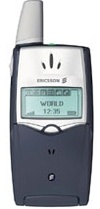 Only 5 years ago, the Internet started to get mobile for me with the launch of the first GPRS networks in Germany and the advent of the first GPRS capable phones. What a different world it was compared to today.
Only 5 years ago, the Internet started to get mobile for me with the launch of the first GPRS networks in Germany and the advent of the first GPRS capable phones. What a different world it was compared to today.
I must have been one of the first GPRS users of the network because at this time and phones and networks were in a shaky beta phase at best. The Ericsson T-39 (first picture on the left) was my first GPRS phone. Equipped with a tiny monochrome display, it could bundle two timeslots to give me a blazing download speed of 25 kbit/s. For web browsing I used a Palm III, also with a monochrome display and one of the first embedded web browsers available at the time. Again, pretty much a beta experience but I loved it.
Yesterday, 5 years later, I was sitting in one of Paris’ best cafés, enjoying good company, an ice cream and discussing mobile lifestyle: Instead of bringing a magazine with me to browse through, my Nokia N70 is always with me ready to take pictures, videos and to connect me to people and the Internet. Here I was, reading the latest news using the Opera browser on the phone, when my eMail client informs me of a new eMail of my publisher in which he informs me that the shipping date for my next book will be July 14th. Great! A little while later, I uploaded some pictures in the background to Flickr which I took in the afternoon while reading some interesting blog entries in the mobile RSS reader at the same time. On the network side, UMTS is much more stable than GPRS was only 5 years ago and data rates have improved from the 25 kbit/s of 5 years ago to 384 kbit/s today.
So what are we in for in 5 years from now? Network speeds will certainly be beyond 8 MBit/s in downlink and 2-3 MBit/s in uplink direction. Prices for mobile data will (hopefully) be at a level to attract the general audience and in combination with the increased bandwidth and services such as video up- and download, LDA applications using the Internet connection and built in GPS receivers will make the application landscape even richer.